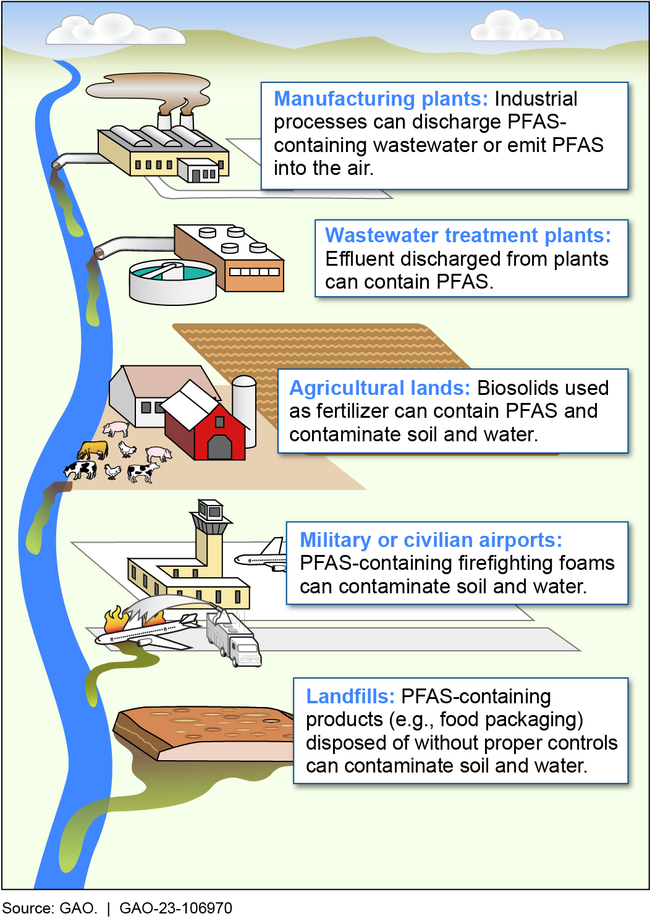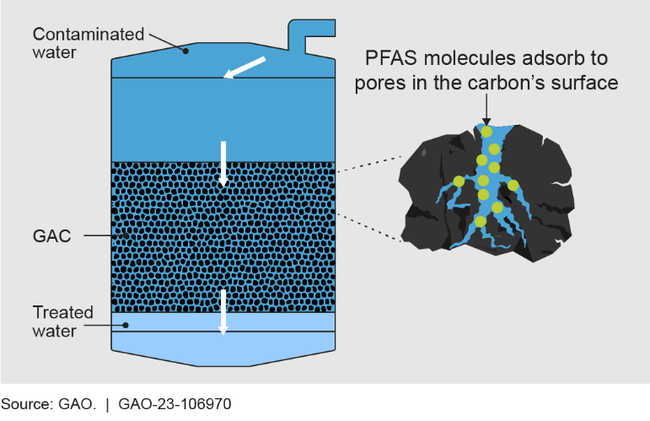Persistent Chemicals: Detecting, Limiting Exposure To, and Treating PFAS Contamination
Fast Facts
A group of chemicals called per- and polyfluoroalkyl substances—PFAS—are used in manufacturing, fire safety, and consumer products including nonstick cookware. But the chemicals contaminate the environment, and some may cause human health problems.
This Snapshot report covers our work on government and other efforts to detect PFAS, prevent exposure, and treat contamination.
For example, technologies like granular activated carbon filters can remove most PFAS from drinking water—but it's unclear how to manage the resulting waste. We've suggested supporting the development and testing of technologies to destroy, dispose of, or store PFAS waste.
Chemical firefighting foam can contain PFAS

Highlights
The Big Picture
The Centers for Disease Control and Prevention found that most people in the U.S. have been exposed to a potentially harmful class of synthetic chemicals called per- and polyfluoroalkyl substances—PFAS, for short. These chemicals have characteristics that make them useful in products such as nonstick cookware, waterproof clothing, and firefighting foams used to extinguish aircraft fires quickly and prevent them from reigniting. Exposure to certain levels of PFAS can cause negative health effects, including cancer.
PFAS can find their way into the air, soil, and water through numerous pathways. Moreover, PFAS can persist in the environment for decades or longer.
In light of the risks that PFAS pose, Congress has taken a number of actions to address PFAS contamination. These include providing funding for grants to water systems to address emerging contaminants, such as PFAS, in drinking water and prohibiting the Department of Defense (DOD) from buying certain products that contain specific PFAS.
However, much about these chemicals remains unknown, including the extent of PFAS contamination across the U.S. and how to safely dispose of or destroy materials containing PFAS—such as the waste byproducts generated when PFAS are removed from drinking water.
What GAO’s Work Shows
Our work has identified actions that could be taken to better detect PFAS occurrence in drinking water, limit human exposure to PFAS, and treat PFAS contamination.
Examples of How Per- and Polyfluoroalkyl Substances (PFAS) Enter the Environment

1. Detecting PFAS Occurrence in Water
More than 4,000 types of PFAS exist, yet much remains unknown about PFAS in drinking water. In September 2022 , we found that at least 18 percent of 5,300 water systems in six states (Illinois, Massachusetts, New Hampshire, New Jersey, Ohio, and Vermont) had concentrations of two PFAS above the levels at which adverse health effects can occur, as identified by the U.S. Environmental Protection Agency (EPA) in 2022. The water systems served nearly 10 million people in states with drinking water regulations or guidance for various PFAS.
In 2023, EPA proposed legally enforceable limits for six PFAS chemicals in drinking water. EPA plans to finalize these regulations in late 2023. If finalized, the regulations would require public water systems to monitor for the six PFAS, notify the public if levels exceed the limits, and reduce the levels in drinking water if they exceed the limits.
Drinking Water May Contain Per- and Polyfluoroalkyl Substances (PFAS)

However, EPA does not currently have nationwide data about the demographic characteristics of communities that have PFAS in their drinking water. Such information could help EPA better understand the extent to which PFAS in drinking water contributes to the cumulative burdens of pollution and ensure adequate protection from PFAS in certain communities.
- Consequently, we recommended that EPA conduct a nationwide analysis using comprehensive data to determine the demographic characteristics of communities with PFAS in their drinking water. EPA agreed, but is still implementing the recommendation.
2. Limiting PFAS Exposure
In November 2022, we found that the Food and Drug Administration (FDA) had worked with companies to voluntarily phase out certain PFAS in food packaging. We also found that for substances like packaging that come in contact with food, FDA does not have specific legal authority to compel companies to provide information on the safety of the substances and the extent of their use—data FDA needs to prioritize and conduct reviews to ensure the safety of products after they are on the market.
Food Packaging May Contain Per- and Polyfluoroalkyl Substances (PFAS)

Consequently, we recommended that FDA request specific legal authority from Congress to compel companies to provide information they have about substances already on the market that come in contact with food. As of May 2023, FDA officials said they were actively considering this recommendation.
Additionally, Congress directed DOD to stop purchasing certain products—such as rugs and cookware—that contain specific PFAS by April 2023. In April 2023, we found that DOD had taken some steps to implement the prohibition. However, DOD had not assessed how to prevent military exchanges from procuring and reselling certain PFAS-containing items. Additionally, DOD had not updated its sustainable procurement guidance to implement PFAS-related policies and legislation. We also found that the information available to guide DOD's actions is limited.
Rugs May Contain Per- and Polyfluoroalkyl Substances (PFAS)

- Consequently, we recommended that DOD (1) develop an approach to implement the prohibition on procuring certain PFAS-containing items, and (2) update its sustainable procurement guidance to implement PFAS-related policies and legislation. DOD agreed but is still implementing the recommendations. Additionally, we recommended that Congress consider aligning prohibitions with available information.
3. Treating PFAS Contamination
In July 2022 , we examined technologies for PFAS assessment, detection, and treatment in various media, such as drinking water and soil. We found that current technologies can remove up to 90 percent or more of 30 different PFAS from drinking water, but that in doing so, they create PFAS-contaminated waste materials as byproducts that then need to be managed.
For example, certain PFAS can be effectively removed from drinking water through filtration with granular activated carbon—which has a large, porous surface area that attracts and binds a wide range of contaminants. However, such filters then create PFAS-contaminated waste that must be properly disposed of or destroyed.
How Granular Activated Carbon (GAC) Filters Remove Per- and Polyfluoroalkyl Substances (PFAS)

It is not yet clear whether existing methods and technologies for destroying PFAS-contaminated materials—such as incineration—are capable of completely converting all PFAS into other, more benign chemical forms.
We have ongoing work examining public water systems' implementation of PFAS treatment methods and efforts to safely destroy, dispose of, or store PFAS-contaminated waste.
Challenges and Opportunities
In addition to our work on specific issues related to detecting PFAS occurrence in drinking water, limiting human exposure to PFAS, and treating PFAS contamination, we also conducted a technology assessment on broader challenges and opportunities for PFAS assessment, detection, and treatment.
As part of that assessment, we developed three policy options for policymakers —Congress, federal agencies, state and local governments, academia, and industry—to:
- promote research to address the limited information on health risks for the large number and diversity of PFAS;
- expand the development of methods to allow researchers to better identify and quantify the thousands of PFAS known to exist; and
- support the development and evaluation of full-scale technologies for disposing of and destroying PFAS.
More from GAO's Portfolio
Technologies for PFAS Assessment, Detection, and Treatment (GAO-22-105088)
For more information, contact at (202) 512-3841 or GomezJ@gao.gov.
